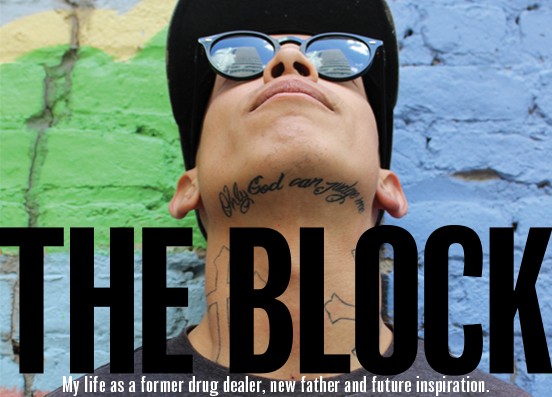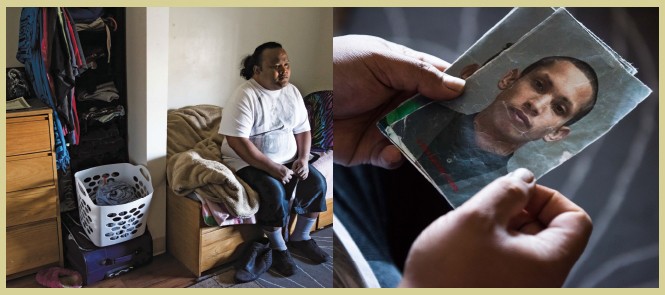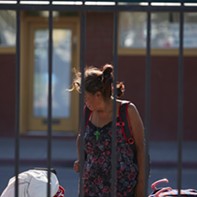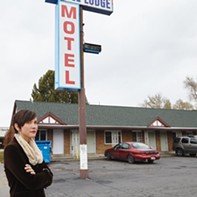The Block
My life as a former drug dealer, new father and future inspiration.
By Stephen Dark @stephenpdarkWhen Gabriel Estrada Zamora was released from jail on Feb. 7, 2015, after serving five months for drug possession and paraphernalia charges, he started looking for work. For several months, the 21-year-old worked construction, then hired on at a McDonald's. As a former drug dealer at Salt Lake City's downtown shelter, Estrada had made $5,000 a week selling meth, heroin and crack cocaine. At the fast-food franchise, he was pulling in $330 weekly for 40-plus hours manning the drive-thru, serving and cleaning. "It was shit work," he says.
By then, Estrada had survived two years as a homeless youth and drug dealer on "the block," as its residents call the streets that surround the shelter where open-air drug dealing and use has become infamously commonplace. Rio Grande "drains you emotionally," Estrada says. "It takes your emotions out. You don't rely on happy feelings, on jealousy, trusting people or anger."
He started dating a McDonald's co-worker, Monic. (About to turn 18, she asked that her last name not be used in this story). She'd found him rude and arrogant—particularly when he pulled on her pigtails—but he also made her laugh.
In October 2015, Monic found out she was pregnant. She told Estrada, "The baby is going to change your life." She was sure his cold heart would soften once he cradled his infant for the first time.
Little Rosana was born fighting for her life, her umbilical cord wrapped five times around her neck. Her heart rate dropped below 30—twice. It took 15 seconds to unravel the cord and get her breathing and crying. Estrada, who had buried his emotions for so long to survive the block, suddenly wanted to cry. "Gabe was so anxious to hold the baby," Monic recalls, "so impatient."
Until now, the Rio Grande shelter debate has been driven largely by public clamor to get rid of the drug-related crime that runs rampant through the surrounding streets. Politicians and even a property developer have spent several nights "undercover" at the shelter, reporting back on nightmarish scenes of violence and drug use. But the voices of those who call the block home generally have been absent.
As Salt Lake City and Salt Lake County have struggled to define the best path to cleaning up Rio Grande, some efforts have focused on the needs of the vulnerable and cracking down on what Utah Speaker of the House Greg Hughes has called "the wolves"—the drug dealers who prowl the area. Estrada's story suggests that evaluating the block's residents needs to be more nuanced. Estrada, after all, went from homeless youth to predator to defendant to family man. He also offers insight into the ad-hoc families that homeless kids form for protection, and the thriving, cartel-controlled economic twilight that writhes there day-in, day-out.
At a time when the homeless shelter discussion in Utah has led to so much angry rhetoric, Estrada's redemption through the love of an infant offers that most-fragile of qualities: hope. He realized with her birth that the image which haunted him as a child—seeing his father behind bars—was the one thing he could not bequeath to her. "I don't want my daughter seeing me how I saw my dad in jail."
The magnitude of the obstacles that Estrada overcame—to make it out of drug dealing and addiction, and into a small apartment living-room with diapers, baby toys and cans of formula—becomes apparent as he surveys six of his 16 mugshots, pronouncing the identity of each face: "Drug addict, drug addict, dealer, mafia kid."
When he taps the one of him in a button-up shirt and vest, with a stubble-lined head and hooded eyes staring coldly into the camera, it's almost as if he can't quite bring himself to look at it. "That's the one I don't want to go back to," he says. "La cara de muerte, the face of death. People always called me that because I smelled of blood and death. There's no fear in my eyes. I just looked dead." He blames the lifeless mask on "things I shouldn't have seen," but declines to elaborate.
Estrada wants to tell his story to show homeless kids they can escape the block. His former street mother, Myra Omar, says that's a message he's already conveyed: "Some of the street kids we both knew left because of his example. He was kind of, like, showing them no matter how deep in the game you get, you can always come out of it."
STING LIKE A BEE
The first time a 19-year-old Estrada checked-in at the downtown shelter in March 2013, he didn't sleep a wink. The smell, the noise, the drug use, the violence—his father throwing him out of his West Valley City apartment had condemned him to this?
That night, he had his duffel bag under his legs, his shoes under his pillow. Unlike many there, he also had other options. He could have called his mother in Bairstow, Calif., and asked for money to come back home, but his pride wouldn't allow it. "I didn't want to show my mother I was fucked," he says. "When that door closed behind me, I took it as the journey of my life, of being homeless, of becoming a man."
The independent-minded youth had stormed out of their West Coast home a few months before, after an argument with his step-father. Estrada's three winter months in Utah with his biological father ended over an argument about a hookah.
After Estrada's night at the shelter, he rode his bike around the block, trying to figure out what to do next. A Pacific-Islander transwoman called out to him, offering to take care of his duffel bag. Myra Omar had long been a fixture at the shelter, Estrada says. She's blessed with pipes like Lady Gaga, fists like Muhammad Ali and an outsized maternal heart for homeless kids. "Everybody knows Myra," he says. "She's a loud Pacific Islander. You're not going to miss seeing a dude in a sarong."
Omar moved to Utah to be with a sister, but a year later in 2011, after her sibling moved out of state, Omar lost her job and for the first time was homeless.
When the baby she was caring for at the shelter died, it sent her into a meth-fueled downward spiral. "When he passed away, I didn't care for life anymore," she says. Omar was a hardcore meth user for three years, calling it her "supermodel phase" because she went from 250 to 120 pounds.
Sitting on the edge of her small cot in one of Safe Haven's apartments in downtown Salt Lake City, she recalls watching over about 50 street kids at the shelter during a five-year span. Omar speaks with a softly melodious voice, swaying slightly side to side as she talks.
To make money, she and her kids would gather in a circle and roll cigarettes with loose tobacco from a local tobacconist and five small rolling machines. She sold the smokes seven for a dollar.
Of all her kids, it was Estrada who stole her heart. "He made sure that he was my special one," she says.
While she was more than capable of administering a beat-down to anyone who threatened one of her clan, her biggest challenge was warding off the allure for some of her brood working for dealers on the men's side of the shelter.
Pastor and street outreach advocate John Welch came to know Omar and Estrada well through his work with Street Krew, a K2 Church-affiliated group that provides friendship and support to the homeless. "As much as [Omar] tries to protect these kids, a lot of the drug dealers prey on [them]," Welch says. "They become an addict and the easiest way to deal with addiction is [to] become a runner for your supplier."
While Omar hated the the dealers' predatory nature, she nevertheless also sold spice cigarettes. Estrada recalls buying containers of spice from a white man in a red SUV for $60 a bottle—$100 for two—and then rolled-out joints, two for $5. If their days were spent making and selling the cigarettes, at night they slept in an abandoned trailer or building, wherever they could nest for the night.
As the long 2013 summer nights continued, Estrada's drug use evolved from spice to meth. "It felt like I drank 100 Red Bulls," he says about the first time he tried the substance. "I didn't feel anything." At the same time, he had a deepening disdain for sleeping rough and making pennies. "I was tired of breaking even with spice and cigarettes," he says. "I wanted to get into a hotel room and sleep in a bed."
THE DEVIL'S SHARE
In July, Estrada decided to explore his options on the men's side of the shelter, where dealers sold 0.2 grams of dope in fingernail-width "balloons" through middlemen and homeless runners. He settled against a black fence and lit up a spice joint. He watched the "spitters," he says, "how they were basically bringing people to them, getting money, pulling a wad out of their pocket, giving change, then they'll spit the balloons in their mouths out."
A self-assured man in blue jeans, a T-shirt and backpack approached him with, Estrada recalls, "the cheesiest smile on his face. He knows he's going to get what he wants."
"¿Qué estás haciendo aquí?" the man asked.
"Nothin'. Chillin'," Estrada replied.
When the Mexican national learned he was smoking spice, he told him in broken English it was bad for him.
"Only thing that's cheap," Estrada recalls answering.
He introduced himself as Hector and asked him if he wanted to work. He spit out 10 balloons of heroin, then pulled out a spice jar with crack in it. "I wiped it off and went around selling it," Estrada says.
When he earned $60 on commission from his sales that day, Estrada told Hector to hold the money for him until he could double it. Hector didn't have to ask twice if he wanted a hotel room. They bought food and clean clothes. Estrada took a shower "and felt good for once."
"Hector was offering something financially that Myra wasn't, which looked to Gabe like a way out," Welch says. "Gabe would have felt that this is exactly the posse I should be rolling with." Get to know Estrada, though, and it was clear, he "needed more of a family than a crew," the advocate adds.
Hector and Estrada shared a similar, prankster sensibility, but differed over drug consumption. Estrada's taste for "white-boy" drugs—meth and heroin—were frowned upon by Hector and other Mexican counterparts. "Those are the devil's drugs," Estrada says. Hector prefered powdered cocaine and alcohol.
Losing one of her kids to a dealer was Omar's nightmare, even more so when it came to Estrada. He was so talkative and friendly—qualities Omar knew were perfect for a dealer in search of good salesmen to exploit.
She was devastated. "Every time I'd hear his name, hear he was on the block, I'd cry." She couldn't help but smart over the ingratitude. "After making him my favorite street kid, the bastard took off and left me hanging," she says. But then, she acknowledges, Hector had more drugs. "Everybody goes through Hector because he had the fattest dope."
Estrada changed, she says. "His character kind of changed a little bit. His ego was—it went from a polite little kid to 'I don't give a fuck' kind of attitude. Sorry for the language." Later, she adds, "There's still a little bit of that Gabriel in him."
Joining forces with Hector ended his relationship with Omar. The second time Estrada went to jail, Omar called his mother in California, even though, from the beginning of their relationship, her street son had told her not to.
When he was released and found out what she had done, he hunted her down on the block. "Why the fuck did you get hold of my family when I asked you not to?" he demanded.
"You expect me to sit here and be worried sick?" Omar fired back. "How do you think your mother feels? Can you imagine what she's going through?"
Estrada can hold a grudge. It would be a year before they began to talk again.
STAND-UP GUY
Hector and Estrada increasingly distanced themselves from the block. They took taxis back-and-forth between their Main Street hotel and the shelter.
"They were letting it be known they were dealing on the block," Welch, says. By then, he had started losing touch with Estrada. "One of the things drug dealers know is it's easier having homeless people become a presence on the block. If you become a presence, that becomes a problem for the police department."
Hector and Estrada stayed at a number of flophouses on State and Main where Estrada could pull the curtains and "chase the dragon"—smoking heroin on tin foil—or shoot-up crack cocaine. Those early months with Hector were "fun times," he says. "It was a brother-romance. We were getting more trusted with each other, he trusted me more with his product."
Estrada went from being a salesman to becoming Hector's accountant, he says, keeping track of the money, sending some to Mexico, investing some in more product and "buying whatever the fuck" he wanted. He went from earning $80 a day with Omar to grossing $5,000 with Hector in a week. He began collecting Ray-Bans and baseball caps by the score.
Omar would come around asking for Estrada, upsetting Hector. "She worries about me; I'm like her kid," Estrada explained. But he refused to talk to her.
Estrada's months of high-end motel living with Hector were rudely interrupted when he was arrested on Jan. 18, 2014, on multiple counts of drug possession and for carrying weapons.
Such was Estrada's unease that night before his arrest, he sought guidance from santería magic. He'd become progressively more involved through Hector with narcotraficante culture—building an altar to the Santa Muerte for protection and listening to narco-corrido ballads celebrating Mexican drug life. He rolled the dice to see what odds and evens came up and got three 3s and three 4s—inconclusive, he thought. So he took a hit of crack and got in the car. The driver eased out of the hotel's street exit onto Main Street at 900 South, heading down to the shelter. Hector was in the passenger seat and a Honduran runner sat next to Estrada in the back, 10 small "balloons" of heroin in his mouth.
They were just 40 feet from the exit when a dozen or more cop cars surrounded them, bathing the four frozen men in blue-and-red flickering light. The Honduran immediately began chugging water to flush the balloons down his throat. Hector muttered in Spanish, "Give me the stuff," but Estrada shook his head. He had outstanding warrants and knew he was jail-bound anyway.
Eventually, he was directed to get out of the car. According to the police report, Estrada was well-armed. He had a meat cleaver hanging from his hip, a butterfly knife in both his left and right pant pockets and a straight razor in his hooded jacket. He also had 16 grams of black tar heroin, 18 grams of meth and 15 grams of crack cocaine, all intended for sale. Total street value, he calculates, was close to $5,000.
Estrada thought he saw fear in Hector's eyes—and that he would turn him in as the cops cuffed him—but his street brother was ready to take the fall.
A WAY OUT
Back in jail for the fourth time, Estrada applied to enter drug court, according to a court docket dated Jan. 13, 2014. In theory, this meant he had to surrender control of his life to Judge Randall Skanchy, and routinely attend group meetings in court for a three-minute report on the progress of his sobriety. Estrada had little, if any, serious intent with drug court initially, signing up only so he could get out of jail. "At first I didn't care; at first I thought it was a waste of time," he says.
Estrada was released on Feb. 28, 2014. He and Hector picked up right where they'd left off, but this time with the added assurance that Estrada had Hector's back.
Estrada's year-long relationship with Hector took him to places and acts he won't talk about. He learned to shut himself down emotionally in order to survive in Hector's world.
He admits he witnessed acts of violence, but whether in Utah or out-of-state isn't clear. Nor is it clear if he participated in those acts. In a notebook he's kept from that time, a former girlfriend wrote that she was scared to break up with him because of who he was, what he did, who his friends were.
The one thing he relied on was Psalm 23, reciting, "The Lord is my shepherd, I shall not walk through the valley of darkness ... "
But the darkness consumed his life, as he attempted suicide three times. "I was getting tired of it, of everything, of the voices in my head saying, 'You're not worth shit anymore, just fucking do it.' 2014 was the darkest year."
After Estrada was arrested at the block on Sept. 11, 2014—asleep on the ground with his girlfriend, a syringe and needle jutting out of his shirt pocket, another by his head—he found himself back in Skanchy's court at the beginning of what would be his longest jail stretch, six months.
The 3rd District judge scolded him and ordered he complete Salt Lake County's Correction Addiction Treatment Services (CATS) program at county jail. Part of the program required him to solicit letters from everyone who loved him, asking, "What did I do to hurt my family with my drug use?"
He chose his mother Maggie Taylor's response to read aloud. She wrote in the December 2014 note that she had never expected in her "wildest dreams," that he would end up a homeless drug-addict in jail. And after she had learned that, things only got worse. "Then when I didn't hear from you, Gabe, I thought you were dead," she wrote. "I hurt my heart. I couldn't make it better. I couldn't help you."
After completing the program, Estrada was scheduled for release from jail on Feb. 17, 2015. However, something was wrong. He'd stopped getting money on his books from Hector. The night before he was released, he learned from another prisoner that Hector had been arrested. Six months later, he was deported.
Instead of being devastated, Estrada felt relief. "I'd found a way out," he says.
VISION OF LOVE
In March 2015, Volunteers of America found 21-year-old Estrada a room at their Salt Lake City transitional home with 13 other males.
When Monic found out she was pregnant, she says, "I didn't think Gabe wanted to help me, but he was happy" at the prospect of being a father.
Estrada started accessing services at the new VOA homeless youth resource center near 900 South and 400 West. "You could tell he had a vision: He knew he wanted to exit homelessness and the lifestyle that it came with," the center's manager Sarah Strang, says. "Gabe would talk about this long-term goal of family and stability," and how he then could start reaching out to homeless kids at the block.
Strang says, after the birth of his daughter, "I don't know I ever saw Gabe without [the baby] in his arms, that shock of dark hair."
With the help of a housing voucher for rental assistance from VOA, Estrada, Monic and their baby moved into an apartment just off State Street in August 2016.
Strang says that Estrada "is achieving success in the way society wants him to succeed," leaving criminality, moving into housing, being engaged with his daughter. He's also juggling two jobs, stacking shelves in a small, family-owned grocery during the day and delivering pizza at night.
The block's temptations rear their head occasionally, whether it's meth addicts smoking under his window, the toxic fumes teasing his nostrils or the thoughts of easy money to be made near the shelter—especially for a young man known for always carrying some "weight." Those who advise and support Estrada know he can take nothing for granted. "Finding your way out of the block doesn't mean you've figured life out," Welch cautions. "But it's a good step in the right direction."
Estrada hopes to graduate from drug court in June, four years after he signed up. His last criminal issue, according to the Utah court docket system, was receiving stolen property on Aug. 18, 2015. Since then, other than a few missed or self-reported dirty drug tests resulting in two- or three-day jail sanctions, Estrada's record has been clean.
In March, Maggie Taylor came out to see her son and his new family. "I saw him at peace. He loves his family," she says, crying softly. "He's a good father and he has a lot of patience."
Estrada's life changed with Rosana's arrival. "I don't go out anymore, I don't do any stupid shit anymore," he says. "It gets me excited [that] she knows I'm her dad. I have a little person to look after and take care of—make sure she's safe, fed, clothed, that she grows up; make sure I give her what I didn't have as a kid." It all boils down to being there. Monic won't take Rosana to see him if he relapses and goes to jail.
Plans in Estrada's future now include mentoring homeless youth for the VOA. To do that, he will have to wait two years, a mandatory requirement by the agency for hiring ex-clients.
Taylor returned to California, deprived of witnessing Estrada taking a bow before a room full of wealthy benefactors. The morning of March 30, he, Monic and Rosana went to the Little America Hotel for a VOA gala breakfast and fundraiser.
In a purple shirt, black tie and Vans, Estrada was the star client chosen by the agency to share his story. After uncharacteristically faltering at the podium, he told the crowd that if it weren't for drug court and VOA, "I wouldn't be standing in front of you."
After he sat down, beneath the glitzy ballroom lights, surrounded by well-dressed advocates and corporate donors, the babble of voices slowly slipped away, until it seemed the world was no more than this: Estrada gazing down at Rosana in his lap as she guzzled milk from a bottle, eyes closed—yet bathing in her father's love.
More by Stephen Dark
-
Call it a Comeback
Long mired in economic depression, Midvale’s Main Street dusts off its small-town charm.
- Sep 20, 2017
-
Love Letters
Correspondence between a young woman at the Topaz internment camp and her beloved sheds light on Trump's America.
- Sep 6, 2017
-
Triggered
Veterans Affairs exists to help vets. So why did the Salt Lake VA appoint an anti-veteran chief?
- Aug 30, 2017
- More »
Latest in Cover Story
Readers also liked…
-
Forget the family pedigree—Robert F. Kennedy Jr should not be the next president of the United States
Trojan Horse
- Jun 21, 2023
-
Women decry harassment and toxic culture at St. George auto dealership
Men at Work
- Oct 11, 2023














